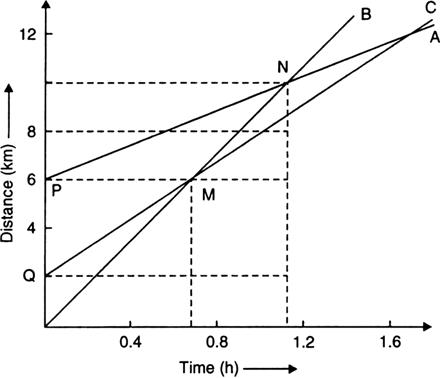Fig. shows the distance-time graph of three objects A, B and C. Study the graph and answer the following questions:
(a) Which of the three is travelling the fastest?
(b) Are all three ever at the same point on the road?
(c) How far has C travelled when B passes A?
(d) How far has B travelled by the time it passes C?


Thus, B is travelling the fastest. Ans.
(ii) No, all three do not meet at any point on the road. Ans.
(iii) When B passes A at point N (at 1.2 hours), C is at a distance of 8 km from the origin O. Ans.
(iv) B passes C at 0.7 hours. During this time B covers distance = 6 km. Ans.
Describe the various types of motions observed in bodies.
Abdul, while driving to school, computes the average speed for his trip to be 20 km h-1. On his return trip along the same route, there is less traffic and the average speed is 30 km h-1. What is the average speed for Abdul’s trip?
A driver of a car travelling at 52 km h–1 applies the brakes and accelerates uniformly in the opposite direction. The car stops in 5 s. Another driver going at 34 km h–1 in another car applies his brakes slowly and stops in 10 s. On the same graph paper, plot the speed versus time graphs for the two cars. Which of the two cars travelled farther after the brakes were applied?
Joseph jogs from one end A to the other end B of a straight 300 m road in 2 minutes and 30 seconds and then turns around and jogs 100 m back to point C in another 1 minute. What are Joseph’s average speeds and velocities in jogging (a) from A to B and (b) from A to C?